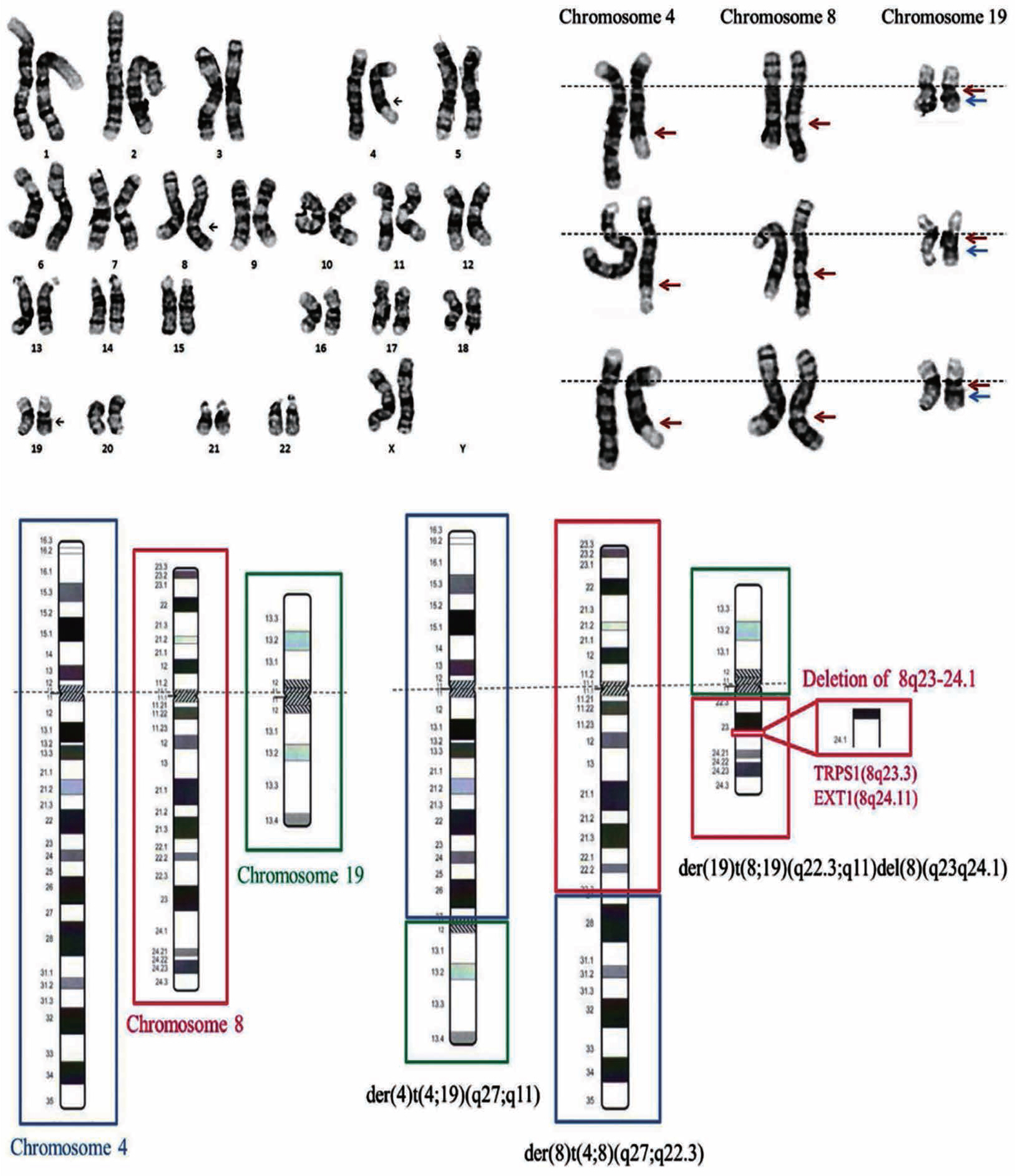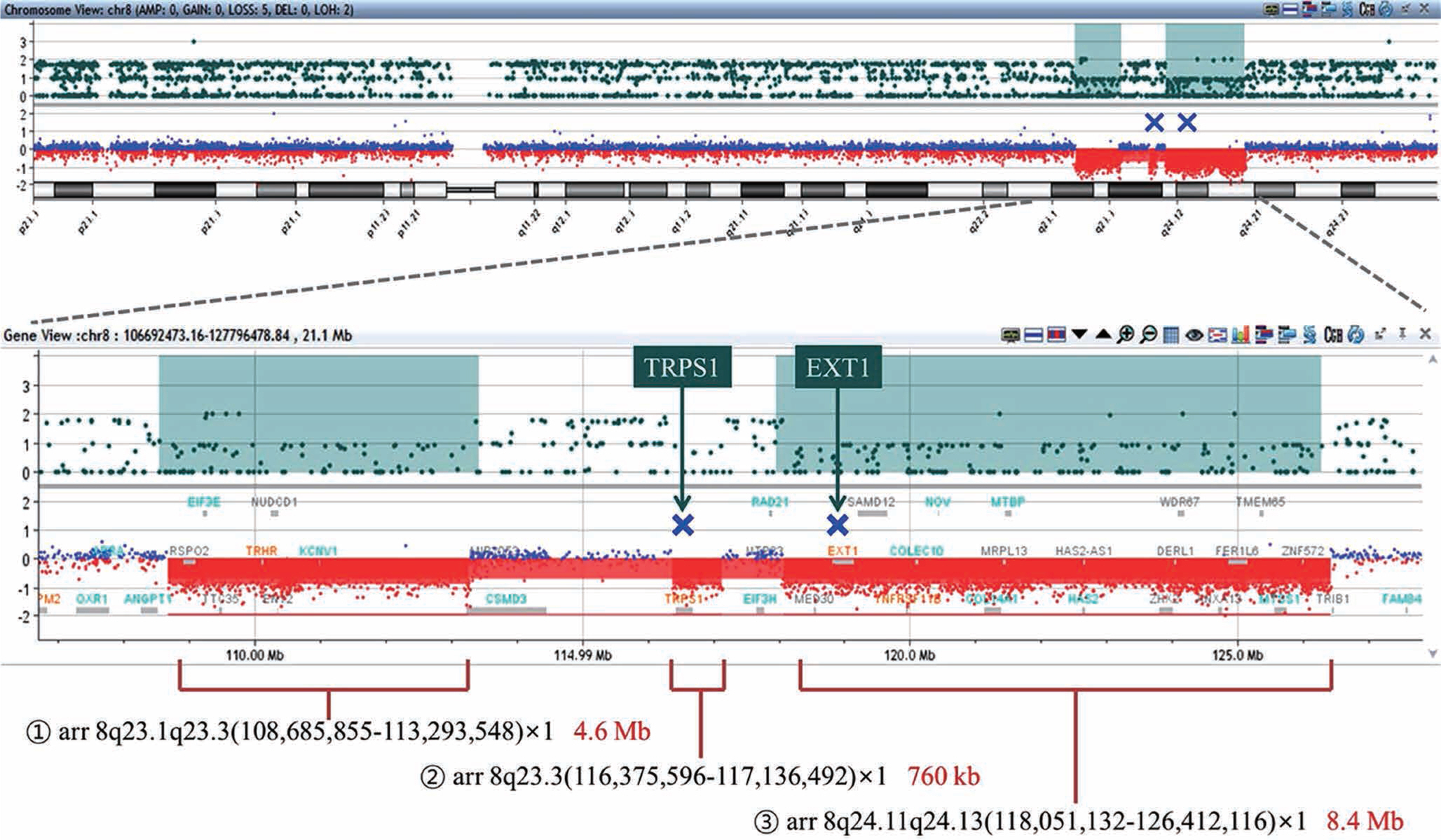Lab Med Online.
2018 Jan;8(1):29-33. 10.3343/lmo.2018.8.1.29.
Langer-Giedion Syndrome with 8q23.1–q24.13 Deletion by Complex Three-way Translocation
- Affiliations
-
- 1Department of Laboratory Medicine, University of Ulsan College of Medicine and Asan Medical Center, Seoul, Korea. ejseo@amc.seoul.kr
- 2Medical Genetics Center, Asan Medical Center, Seoul, Korea.
- 3Department of Pediatrics, University of Ulsan College of Medicine and Asan Medical Center Children's Hospital, Seoul, Korea.
- 4Department of Laboratory Medicine, Gyeongsang National University Hospital, Jinju, Korea.
- KMID: 2398417
- DOI: http://doi.org/10.3343/lmo.2018.8.1.29
Abstract
- Langer-Giedion syndrome is a very rare genetic disorder that is caused by the deletion on chromosome 8q24.1, encompassing the TRPS1 and EXT1 genes. We describe a 5-month-old female patient who was admitted to our hospital with clinodactyly and weakness in both thumbs. The patient's karyotype was 46,XX,der(4)t(4;19)(q27;q11),der(8)t(4;8)(q27;q22.3),der(19)t(8;19)(q22.3;q11)del(8)(q23q24.1). Multiplex ligation-dependent probe amplification (MLPA) analysis showed that the patient had a heterozygous deletion, rsa 8q24(P064)x1 and rsa 8q24(P245)x1. Array comparative genomic hybridization (CGH) analysis further revealed three interstitial deletions spanning a total of 13.7 Mb at 8q23.1-q24.13. Based on clinical findings and confirmation by cytogenetic, MLPA, and array CGH analyses, the patient was diagnosed with sporadic Langer-Giedion syndrome with three-way translocations. This is the first case of Langer-Giedion syndrome with complex chromosomal rearrangements in Korea.
Keyword
MeSH Terms
Figure
Reference
-
1.Pereza N., Severinski S., Ostojić S., Volk M., Maver A., Dekanić KB, et al. Third case of 8q23.3–q24.13 deletion in a patient with Langer–Giedion syndrome phenotype without TRPS1 gene deletion. Am J Med Genet A. 2012. 158A:659–63.
Article2.Shin HT., Chang MW. Trichorhinophalangeal syndrome, type II (Langer–Giedion syndrome). Dermatol Online J. 2001. 7:8.
Article3.Cappuccio G., Genesio R., Ronga V., Casertano A., Izzo A., Riccio MP, et al. Complex chromosomal rearrangements causing Langer–Giedion syndrome atypical phenotype: genotype–phenotype correlation and literature review. Am J Med Genet A. 2014. 164A:753–9.
Article4.Hall BD., Langer LO Jr., Giedion A., Smith DW., Cohen MM., Beals RK, et al. Langer–Giedion syndrome. Birth Defects Orig Artic Ser. 1974. 10:147–64.5.Chen CP., Lin MH., Chen YY., Chern SR., Chen YN., Wu PS, et al. Prenatal diagnosis and array comparative genomic hybridization characterization of interstitial deletions of 8q23.3–q24.11 and 8q24.13 associated with Langer–Giedion syndrome, Cornelia de Lange syndrome and haploinsuffciency of TRPS1, RAD21 and EXT1. Taiwan J Obstet Gy-necol. 2015. 54:592–6.6.OMIM. https://omim.org/entry/190350. (updated on May 2016).7.OMIM. https://omim.org/entry/133700. (updated on Nov 2009).8.Pannier S., Legeai-Mallet L. Hereditary multiple exostoses and enchondromatosis. Best Pract Res Clin Rheumatol. 2008. 22:45–54.
Article9.Wuyts W., Roland D., Lüdecke HJ., Wauters J., Foulon M., Van Hul W, et al. Multiple exostoses, mental retardation, hypertrichosis, and brain abnormalities in a boy with a de novo 8q24 submicroscopic interstitial deletion. Am J Med Genet. 2002. 113:326–32.
Article10.Langer LO Jr., Krassikoff N., Laxova R., Scheer-Williams M., Lutter LD., Gorlin RJ, et al. The tricho-rhino-phalangeal syndrome with exostoses (or Langer-Giedion syndrome): four additional patients without mental retardation and review of the literature. Am J Med Genet. 1984. 19:81–112.
Article11.Riedl S., Giedion A., Schweitzer K., Müllner-Eidenböck A., Grill F., Frisch H, et al. Pronounced short stature in a girl with tricho-rhino-phalangeal syndrome II (TRPS II, Langer–Giedion syndrome) and growth hormone defciency. Am J Med Genet A. 2004. 131A:200–3.
- Full Text Links
- Actions
-
Cited
- CITED
-
- Close
- Share
- Similar articles
-
- A Case of Langer-Giedion Syndrome with a De Novo Del(8)(q23q24.1)
- A Case of Schinzel-Giedion Syndrome
- A Case of Del 13(q24) Syndrome with Multiple Anomalies
- Miller-Dieker Syndrome with der(17)t(12;17)(q24.33;p13.3)pat Presenting with a Potential Risk of Mis-identification as a de novo Submicroscopic Deletion of 17p13.3
- Variant Burkitt-type translocation (8;22)(q24;q11) in plasma cell myeloma



